|
In this section
the topics covered
are;

-
How
ewe nutrition
affects wool and
liveweight of the
progeny
-
Improved ewe
nutrition in
late-pregnancy
increases progeny
wool quality and
quality
-
Improved ewe
nutrition for better
weaner growth and
survival
The impact of
nutrition on placental
growth
Poor nutrition
throughout pregnancy can
affect lamb growth and
development due to
restrictions in the growth
of the placenta (the channel
that carries all nutrients
to the developing foetus)
and foetus.
The placenta and
foetus are most susceptible
to restrictions in the
nutrition of the ewe during
the periods when their
growth is most rapid.
For the first 50 days of
pregnancy, growth of the
placenta and foetus is
minimal (early
pregnancy). In mid
pregnancy, day 50-100,
foetal growth is minimal
while growth of the placenta
is rapid, and in
late-pregnancy, day 100-150,
growth of the placenta is
complete and growth of the
foetus increases rapidly
until birth.
Reducing the
nutrition of the ewe in mid
pregnancy can reduce the
size and functionality of
the placenta and
restrictions during
late-pregnancy can reduce
the growth rate and size of
the foetus.
The development
of wool follicles in
lambs
The lamb's
future wool production is
affected by ewe nutrition
during pregnancy.
Primary follicle (large
fibres) development occurs
in the growing foetus from
around Day 60 of pregnancy
and is completed by around
Day 90. Secondary
follicles (fine fibres) are
the most important part of
the wool producing
factory. They develop
from around day 90 to birth,
with some follicle
maturation occurring in the
first month of the lamb's
life. The density of
follicles is determined
prior to birth and will not
change for the entire life
of the animal.
Secondary
follicles are the most
important part of the wool
producing skin, having a
direct influence on the
density and fineness of the
fleece. A reduction in
nutrient supply to the
developing foetus at this
time (either because of poor
nutrition or because there
are multiple foetuses
competing for nutrients)
will significantly impact on
the development and final
density of secondary
follicles.
Higher secondary
follicle density is
associated with lower fibre
diameter and higher fleece
weight and these effects
persist throughout the
lifetime of the progeny. The
secondary follicles
contribute the majority of
fibres to the adult wool
fleece. The number of
primary compared to
secondary follicles is often
called the 'primary to
secondary ratio'. The
development of primary and
secondary follicles in the
lamb is illustrated below.
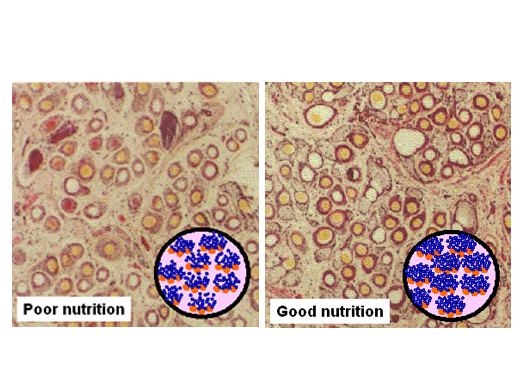
The impact of
ewe condition in pregnancy
on the progeny's performance
Lifetime wool
production and quality are
effected by ewe nutrition
during pregnancy.
There are linear
relationships between
changes in ewe condition and
the amount and quality of
wool produced by single and
twin lambs.
The effects of
changes in ewe Condition
Score (CS) during early or
late-pregnancy have a
similar effect on hogget
clean fleece weight and
fibre diameter and the
responses are linear.
-
an increase of
+1 CS equals +0.2 kg
clean fleece weight
and reduction of 0.4
micron.
-
ewes that lose
0.5 CS and then gain
0.5 CS to lambing,
produce progeny that
will cut the same
amount and fibre
diameter of wool as
those from ewes that
maintain CS
throughout
pregnancy.
The effects of
early and late-pregnancy
nutrition on progeny wool
production and quality are
additive and permanent
throughout the animal's
lifetime. They cannot
be fully compensated for by
improved nutrition after
birth.
Improved ewe
nutrition in pregnancy
increases progeny fleece
weight
The effect of
nutrition in early to
mid-pregnancy on progeny
fleece weight is outlined in
LTEM 3.6. A loss of
0.5 CS in early to
mid-pregnancy reduces
progeny clean fleece weight
by 0.1 kg in both single and
twin bearing ewes.
Twin lambs produce 0.3 kg
less wool than single lambs.
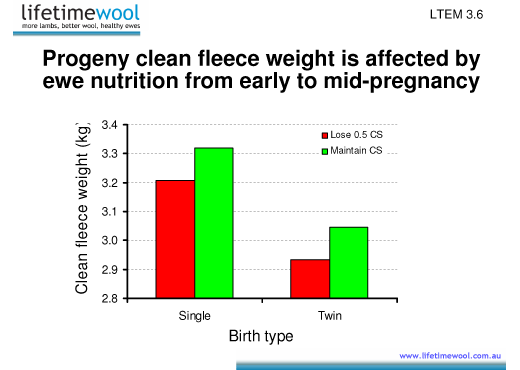
The effect of
nutrition in late-pregnancy
on progeny fleece weight is
outlined in LTEM 4.9.
A loss of 1 CS in
late-pregnancy reduces
progeny clean fleece weight
by 0.2 kg in both single and
twin lambs. Twin lambs
produce 0.3 kg less wool
than single born lambs.
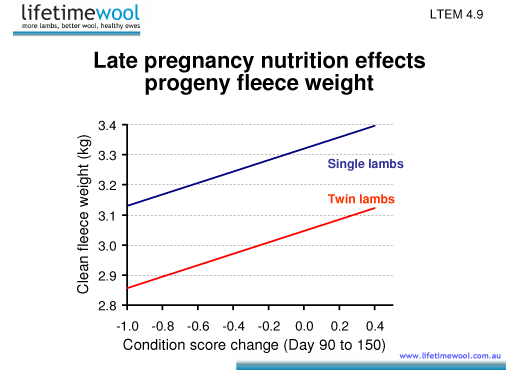
Increasing FOO
in late-pregnancy will
affect the progeny fleece
characteristics by
influencing up to a 200 gram
increase in clean fleece
weight.
Poor ewe
nutrition increases progeny
fibre diameter
The effect of
nutrition in early to
mid-pregnancy on progeny
fibre diameter is outlined
in LTEM 3.7. A loss of
0.5 CS in early to
mid-pregnancy increases the
progeny fibre diameter by
0.2 micron in both single
and twin lambs. Twin
lambs produce wool that is
0.3 micron broader than
single lambs.
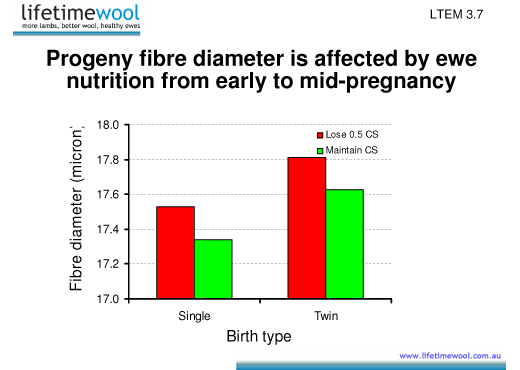
The effect of
nutrition in late-pregnancy
on progeny fibre diameter is
outlined in LTEM 4.10.
A loss of 1 CS in
late-pregnancy increases the
progeny fibre diameter by
0.4 micron in both single
and twin lambs. Twin
lambs produce wool that is
0.3 micron broader than wool
from single born lambs.
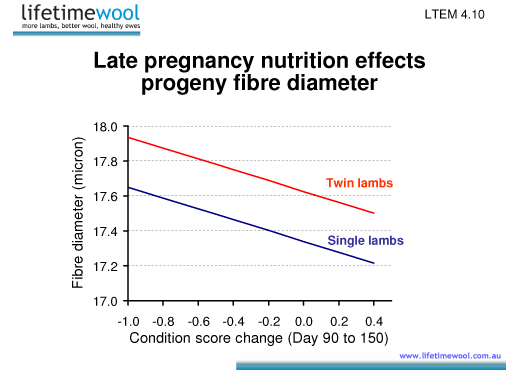
The impact of
ewe nutrition on lamb growth
rates and weaner quality
Improved ewe
nutrition through lactation
means bigger weaners and
better weaner
survival. A lamb born
at 5kg that grows at
200grams per day (LTEM 5.1)
will be about 20kg when
weaned at 14 weeks (LTEM
5.2).
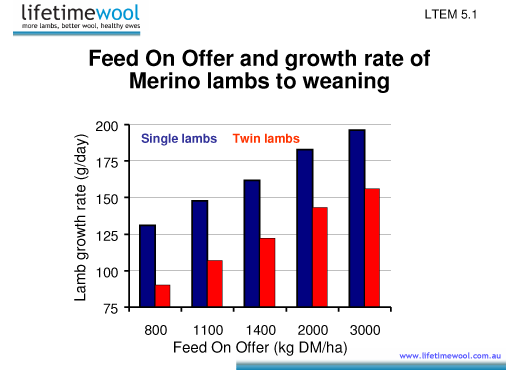
Feed-On-Offer
during lactation is the main
factor driving lamb growth
rates. Lamb growth
rates of 200 grams per day
for single lambs are
achieved when FOO is 1100 kg
DM/ha or
more.
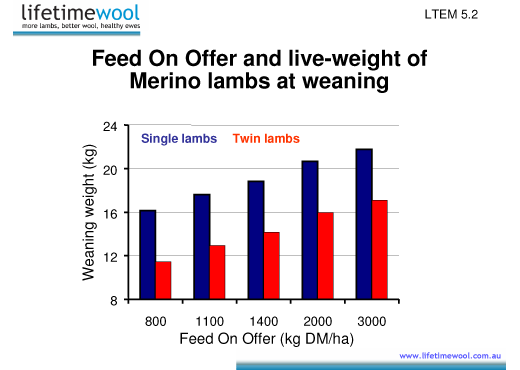
The FOO targets
for lactation to maximize
survival and achieve weaner
live weights of about 40% of
Adult size (Standard
Refereence Weight) at 12-13
weeks are:
Singles: 1400
kgDM/ha
Twins:
2000 kgDM/ha
The impact of
weaning weight on weaner
survival
Live-weight at
weaning explains 95% of the
differences in weaner
mortality. It is the most
important factor for weaner
survival. Weaner
survival is best when the
lamb is over 20 kg (for a
small frame merino) or 25kg
(for a medium frame merino)
at weaning.
Preferential treatment of
lighter weaners post-weaning
should be standard practice.
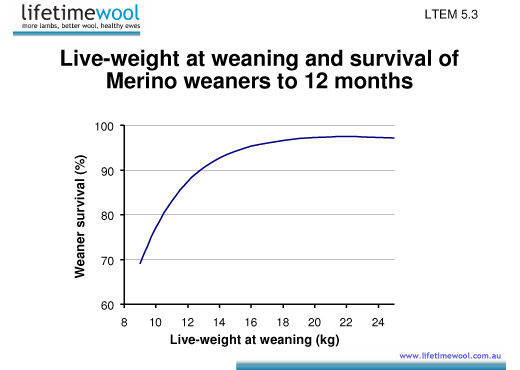
Back to
Top
|